The 30 Best Places to Live in South Carolina

South Carolina offers residents an exceptional blend of southern charm, natural beauty, and economic opportunity across its diverse communities.
The Palmetto State features everything from historic coastal cities and thriving metropolitan areas to charming small towns and lakeside communities, each providing unique advantages for different lifestyles and preferences.
This comprehensive guide examines the 30 best places to live in South Carolina, evaluating communities based on factors like cost of living, employment opportunities, school quality, and recreational amenities.
From bustling downtown districts in major cities like Charleston and Greenville to peaceful suburban neighborhoods and coastal retreats, these locations represent the top residential options throughout the state.
The analysis considers key elements that matter most to residents, including lifestyle opportunities and practical considerations for making an informed housing decision.
Here are the 30 best places to live in South Carolina:
30. Simpsonville East

Simpsonville East offers residents a blend of suburban charm and urban convenience in Greenville County. This area attracts families seeking quality schools and a strong community atmosphere.
The neighborhood features well-maintained residential streets with diverse housing options. Home values remain competitive compared to other Upstate South Carolina markets.
Residents enjoy access to several parks and recreational facilities. The area’s proximity to major highways provides easy commutes to Greenville and surrounding cities.
Local amenities include shopping centers and dining establishments within walking distance. The community maintains a family-friendly environment with active neighborhood associations.
Public schools in the area receive positive ratings from parents and education officials. The location offers a quieter alternative to downtown living while maintaining accessibility to employment centers.
Simpsonville East continues to grow as young professionals and retirees discover its appeal. The area balances residential tranquility with practical access to services and entertainment options.
29. Florence Southside
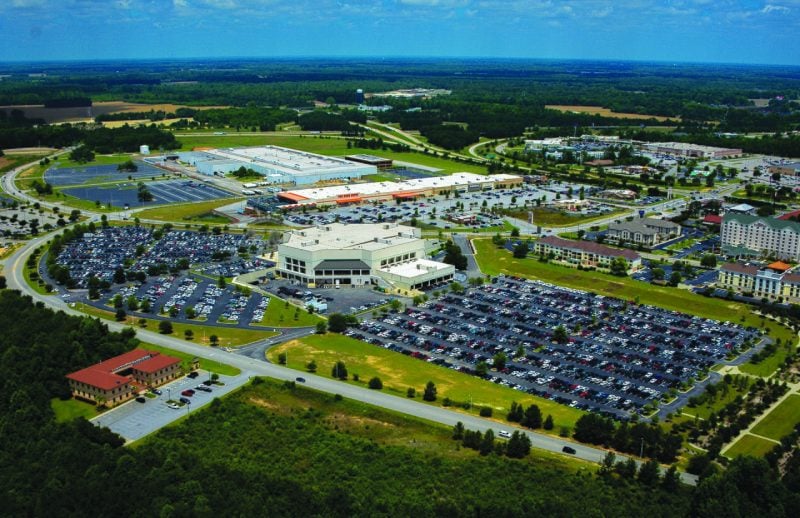
Florence Southside offers residents a blend of suburban comfort and urban convenience in the heart of the Pee Dee region. The area features established neighborhoods with mature trees and well-maintained homes.
Housing costs remain below South Carolina’s state average. This makes the area attractive for first-time buyers and families seeking affordable options.
The neighborhood provides easy access to Florence’s downtown business district and shopping centers. Residents can reach major employers and amenities within minutes.
Local schools serve the community with several options for families. The area maintains a quiet residential atmosphere while staying connected to city services.
Florence Southside sits near major transportation routes including Interstate 95. This location benefits commuters and provides convenient travel access throughout the region.
The community attracts residents who value established neighborhoods with reasonable home prices and proximity to Florence’s amenities.
28. Fort Mill Central
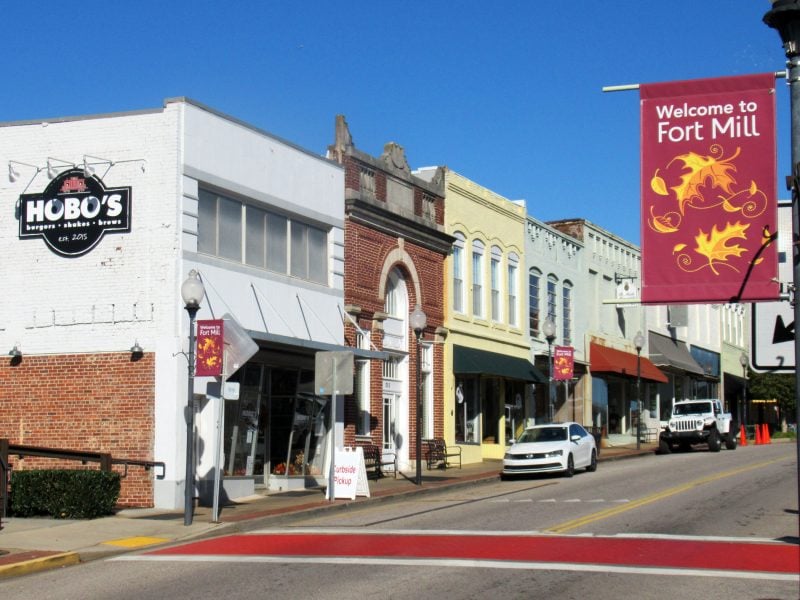
Fort Mill Central offers residents a prime location within this growing York County community. The area sits near the heart of Fort Mill, providing easy access to local amenities and services.
This central location places residents just minutes from Charlotte, North Carolina. Commuters benefit from the proximity to major employment centers while enjoying a suburban atmosphere.
The neighborhood features a mix of housing options suitable for various budgets. Home values in Fort Mill exceed the South Carolina state average, reflecting the area’s desirability.
Families appreciate the community-oriented lifestyle that characterizes Fort Mill Central. The area maintains its small-town charm while offering modern conveniences.
Local schools and parks serve the neighborhood well. Residents can access shopping, dining, and entertainment options without traveling far from home.
The central location provides connectivity to other popular Fort Mill neighborhoods and developments.
27. Bluffton Old Town
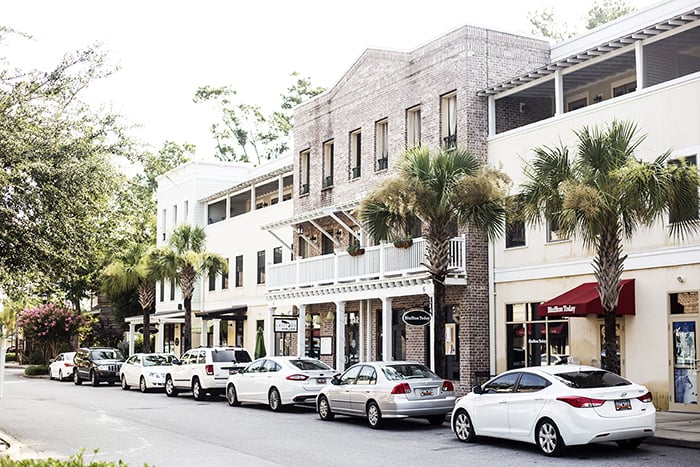
Bluffton Old Town represents the historic heart of this Lowcountry community. Founded in 1852, the area has been carefully preserved to maintain its authentic Southern charm and historical significance.
The district features tree-lined streets with antebellum architecture and historic homes. Many of these structures date back to the 19th century and showcase traditional Lowcountry design elements.
Residents enjoy walkable streets that connect to local shops, restaurants, and galleries. The area maintains a small-town atmosphere while offering modern amenities and conveniences.
Old Town sits along the May River, providing scenic water views and access to boating activities. The location offers a peaceful setting with natural beauty throughout the neighborhood.
The historic district attracts families and retirees who appreciate the blend of preservation and community character. Property values reflect the desirability of this authentic coastal location.
26. Hilton Head Westin Area

The Hilton Head Westin Area offers prime oceanfront living on one of South Carolina’s most desirable barrier islands. This upscale neighborhood centers around the luxury resort while providing residential options nearby.
Residents enjoy direct beach access and world-class amenities. The area features high-end condominiums and vacation rentals within walking distance of pristine shores.
The location provides easy access to championship golf courses and fine dining establishments. Shopping and entertainment options are readily available throughout the island.
Home values in this area reflect the premium coastal location and resort amenities. The neighborhood attracts both permanent residents and seasonal visitors seeking luxury accommodations.
The Westin Area benefits from Hilton Head’s year-round mild climate and minimal snowfall. Proximity to Savannah, Georgia adds convenience for accessing larger city amenities while maintaining island living.
25. Downtown Greenville
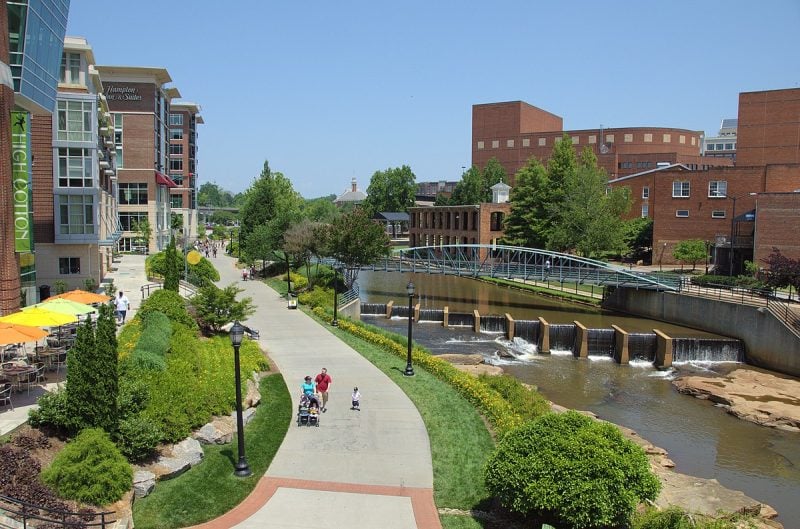
Downtown Greenville stands as one of South Carolina’s premier urban neighborhoods. The area ranks among the top 100 places to live in the United States.
Residents enjoy award-winning downtown amenities and a thriving local economy. The neighborhood seamlessly blends historic charm with modern development.
Falls Park on the Reedy serves as a centerpiece attraction with its downtown waterfall. The Swamp Rabbit Trail provides excellent recreational opportunities for cycling and walking.
The district features diverse shopping areas, restaurants, and entertainment venues. Movie theaters and live music clubs offer regular nightlife options.
Housing choices vary from historic properties to luxury developments. The cost of living remains below national averages while providing urban conveniences.
Top-rated schools serve the area along with quality public amenities. The location provides easy access to the Blue Ridge Mountains for outdoor activities.
24. Mount Pleasant West
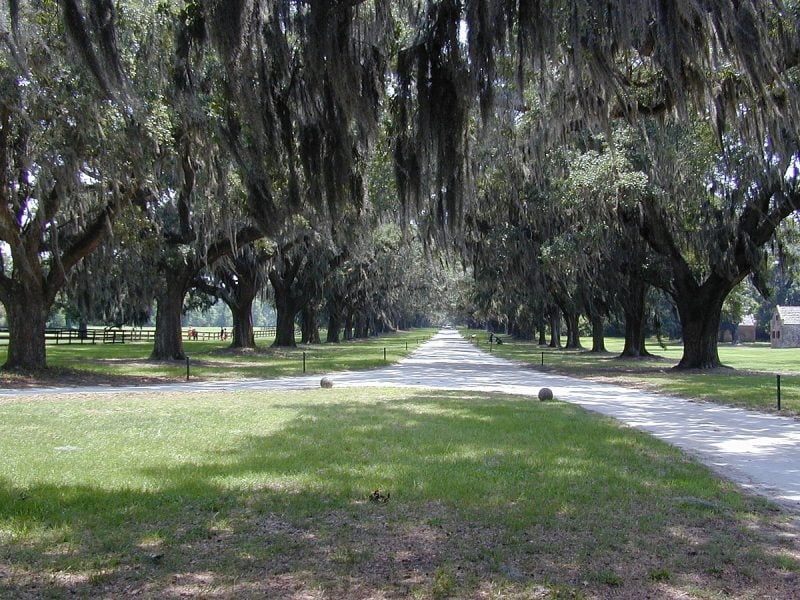
Mount Pleasant West sits in the interior portion of Mount Pleasant, offering residents a more affordable alternative to waterfront neighborhoods. This area maintains the town’s suburban character while providing easier access to Interstate 526 and downtown Charleston.
The neighborhood features established residential streets with mature trees and traditional Southern architecture. Home prices in Mount Pleasant West typically run lower than the coastal sections, making it attractive for families and young professionals.
Residents enjoy proximity to Mount Pleasant’s amenities including parks, shopping centers, and dining options along major corridors. The area provides good access to local schools within the highly-rated Charleston County School District.
Mount Pleasant West offers a balance between small-town charm and urban convenience. The location allows for reasonable commutes to Charleston’s business district while maintaining the quieter pace of suburban living that characterizes Mount Pleasant.
23. Rock Hill South
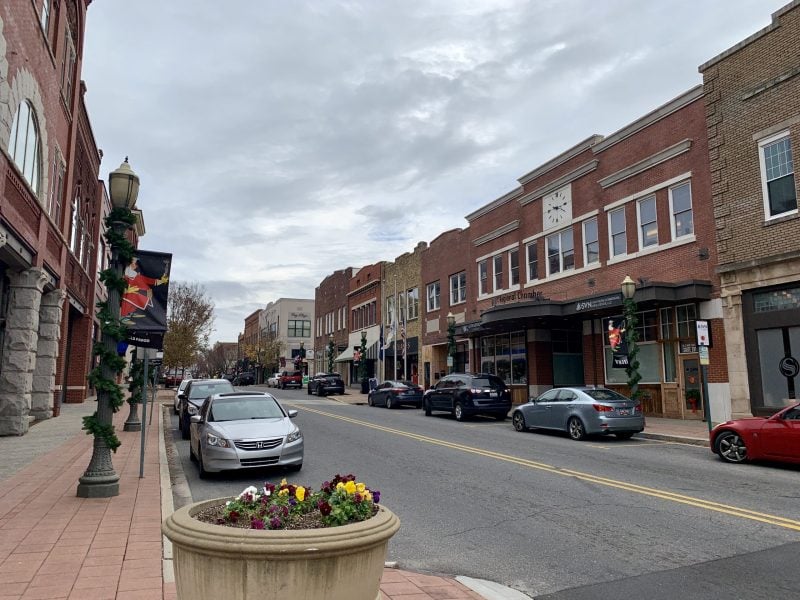
Rock Hill earned the #5 spot on U.S. News & World Report’s 2025-2026 rankings of Best Places to Live in South Carolina. The city combines affordability with proximity to Charlotte, making it attractive for families and professionals.
Home prices in Rock Hill align with South Carolina’s state average of $233,397. This pricing offers value compared to nearby metropolitan areas while maintaining access to urban amenities.
The city features diverse neighborhoods including the historic Winthrop University Area with tree-lined streets. Newport offers a planned community atmosphere with family-friendly amenities and quality schools.
India Hook provides upscale living near Lake Wylie with larger homes and natural beauty. Each area caters to different lifestyle preferences while maintaining Rock Hill’s community character.
Rock Hill’s location provides easy access to Charlotte’s job market and cultural offerings. The city maintains its own identity while benefiting from metropolitan proximity.
22. Sumter East
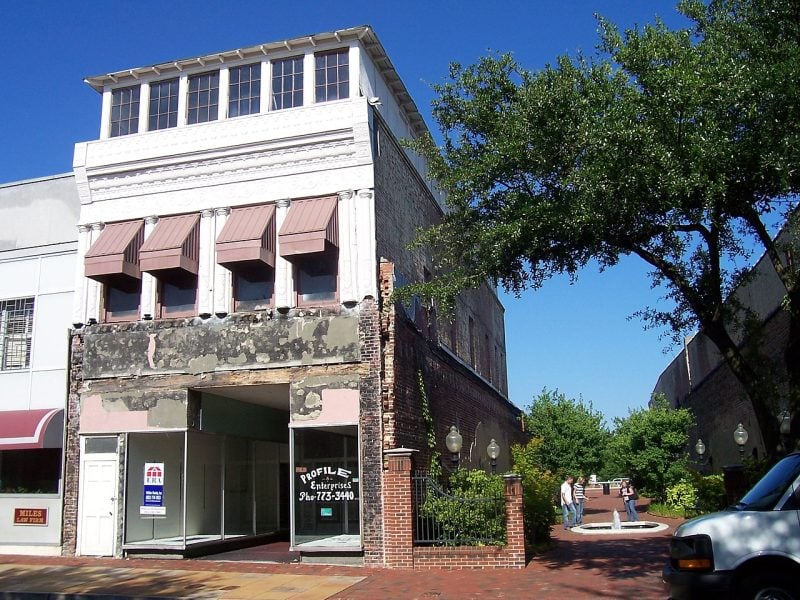
Sumter East offers residents a suburban rural mix that appeals to families and retirees. Most residents own their homes in this area, contributing to neighborhood stability.
The community provides small-town charm while maintaining proximity to larger cities. Residents can reach Columbia within 30 minutes and Charlotte in about an hour.
Living costs remain affordable compared to other South Carolina locations. The area features natural beauty and hospitality that residents value.
The geographical footprint allows for both suburban conveniences and rural tranquility. This balance attracts those seeking a quieter lifestyle without complete isolation.
Sumter East sits in the coastal plains region, providing a medium-size metro area feel. The location offers access to local amenities while preserving the peaceful atmosphere many residents prefer.
21. Walterboro
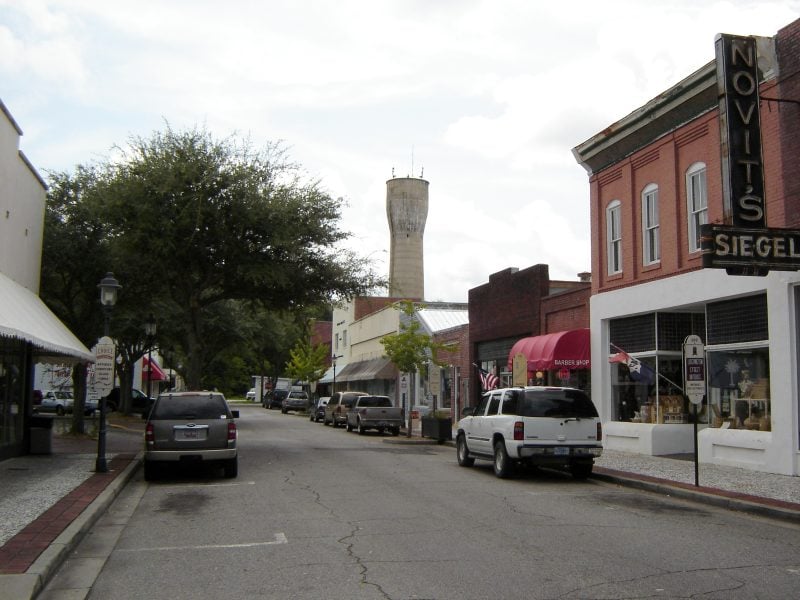
Walterboro is a small town in Colleton County with a population of 5,490 residents. The community offers a sparse suburban feel where most residents own their homes.
Home prices in Walterboro are significantly below South Carolina’s state average of $233,397. This affordability makes it attractive for buyers seeking lower housing costs.
The town appeals particularly to retirees who appreciate its quiet atmosphere. Many residents tend to lean liberal politically.
Walterboro provides abundant recreational opportunities through its numerous parks and outdoor areas. The mild climate allows for year-round outdoor activities.
The town maintains a safe, friendly community environment while staying connected to modern amenities. Its location offers proximity to nature without sacrificing convenience.
Walterboro has received a livability score of 56 out of 100 based on various factors including amenities and employment opportunities.
20. Myrtle Beach North
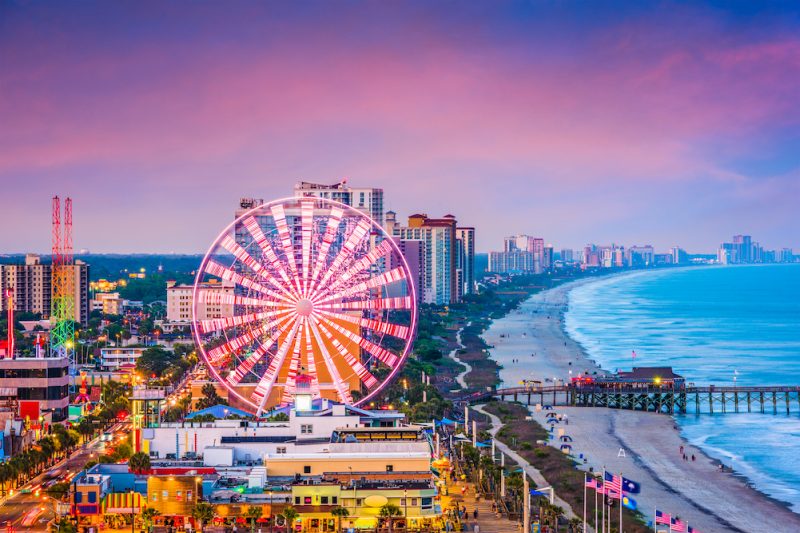
Myrtle Beach North offers a quieter alternative to the bustling main strip while maintaining easy beach access. This area attracts families and retirees seeking coastal living without constant tourist crowds.
The region features several well-planned neighborhoods with modern amenities. Residents enjoy proximity to championship golf courses and waterfront dining options.
Housing costs remain more affordable compared to other South Carolina coastal areas. The community benefits from Horry County’s growing economy and healthcare infrastructure.
Myrtle Beach North provides convenient access to both natural attractions and urban conveniences. The area sits near the Intracoastal Waterway, offering boating and fishing opportunities.
Schools in the district serve growing residential communities. The location allows residents to enjoy beach lifestyle benefits while avoiding heavy tourism traffic that affects central Myrtle Beach areas.
19. North Charleston
North Charleston offers residents a more affordable alternative to downtown Charleston living. Home prices remain below the state average of $233,397, making it attractive for budget-conscious buyers.
The city provides convenient access to Charleston’s amenities while maintaining its own distinct character. Residents enjoy shorter commutes to major employment centers and cultural attractions.
North Charleston features diverse neighborhoods with varying price points and housing styles. The area continues developing new residential and commercial projects.
Public transportation options connect North Charleston to surrounding areas. The city’s location provides easy access to beaches, historic sites, and recreational opportunities.
Local amenities include parks, shopping centers, and dining establishments. The job market benefits from proximity to Charleston’s economy and the Port of Charleston.
18. Lake City
Lake City sits in northeast South Carolina, approximately 50 miles from the North Carolina border. This small railroad town offers affordable living options with home prices significantly below the state average of $233,397.
The community provides quality educational institutions and reliable healthcare facilities. These amenities make it particularly attractive for families considering relocation to the area.
Lake City maintains the charm of a small town while offering essential services and conveniences. The location provides easy access to larger metropolitan areas when needed.
Residents benefit from the area’s affordability and family-friendly atmosphere. The town’s size creates a close-knit community environment where neighbors know each other.
The combination of low housing costs and essential amenities makes Lake City a practical choice for those seeking small-town living in South Carolina.
17. Aiken
Aiken offers residents an appealing combination of affordability and quality amenities. The city’s cost of living sits about 15% below the national average, making it an attractive option for many families.
The area boasts the second-best school district in the region according to rankings. This educational quality draws families seeking strong academic opportunities for their children.
Aiken’s equestrian culture sets it apart from other South Carolina cities. The town hosts numerous horse-related events and activities throughout the year.
Housing costs remain reasonable compared to state averages. Home prices typically fall below South Carolina’s median of $233,397, providing good value for buyers.
The city ranks among the top retirement destinations in South Carolina. Its friendly community atmosphere and manageable size contribute to this reputation.
Aiken’s location near Augusta, Georgia provides residents access to additional employment and entertainment options while maintaining small-town charm.
16. Tega Cay
Tega Cay ranks as South Carolina’s top place to live in 2025 according to Niche rankings. The city earned an A+ overall score for its exceptional quality of life.
Located in York County near Lake Wylie, Tega Cay serves as a Charlotte suburb with approximately 13,000 residents. The community offers a suburban feel while maintaining access to outdoor recreational activities.
The city excels in education with highly rated public schools receiving A+ grades. Families make up a significant portion of the population, drawn by the safe, family-friendly environment.
Tega Cay consistently ranks among South Carolina’s safest cities with notably low crime rates. Most residents own their homes in this well-established community.
Housing costs exceed the state average, reflecting the area’s desirability and quality amenities. The city provides residents with numerous parks and recreational opportunities centered around its lakefront location.
15. Greer
Greer ranks as the 14th best place to live in South Carolina out of 188 cities. This small city in Greenville County serves as a northern suburb of Greenville with a population of 39,191 residents.
The city offers a low cost of living and low unemployment rate. Most residents own their homes in this dense suburban community.
Greer provides excellent schools and numerous parks for families. The area attracts both families and young professionals looking to settle down.
Home prices in Greer align with South Carolina’s average of $233,397. The real estate market reflects stable housing costs throughout the region.
Located in the Upstate region, Greer benefits from job opportunities in nearby Spartanburg County. The city continues growing as one of South Carolina’s fastest-expanding communities.
Residents enjoy access to local attractions and community amenities. The city maintains its appeal through practical benefits like affordability and quality education options.
14. Goose Creek
Goose Creek stands as a prime suburb of Charleston with a population of 46,964 residents. The city sits in Berkeley County and offers residents a sparse suburban atmosphere where most people own their homes.
Home prices in Goose Creek align closely with South Carolina’s state average of $233,397. This affordability makes it accessible for many families seeking homeownership in the Charleston area.
The city benefits from its strategic location between major employers Volvo and Boeing. These industry giants provide substantial job opportunities for residents within a short commute.
Goose Creek has earned recognition from Business Week as “The Best Place to Raise a Family” in South Carolina. Money magazine has also featured it among their Best Places to Live selections.
The community maintains a small-town feel while experiencing steady growth and development. Residents enjoy proximity to Charleston’s beaches while living in a family-friendly environment with strong community values.
13. Florence
Florence stands as the largest city in South Carolina’s Pee Dee region. The city offers residents a blend of urban conveniences and suburban comfort.
Housing costs remain affordable compared to many areas across the state. Florence home prices fall below South Carolina’s average, making homeownership accessible for many families.
The local economy provides diverse job opportunities across multiple sectors. This economic stability attracts both young professionals and established families to the area.
Florence features safe neighborhoods throughout the city. Residents benefit from various amenities and community attractions that enhance daily life.
The city ranks among South Carolina’s notable places to live. Florence combines practical advantages like cost-effective living with quality schools and local services that support community growth.
12. Anderson
Anderson offers an attractive combination of affordability and Southern charm in northwest South Carolina. The city earned recognition from AARP as one of the “Best Places to Live and Retire Now” in 2021.
Home prices in Anderson remain below the state average of $233,397. This affordability makes it accessible for both young families and retirees seeking quality living without high costs.
The community maintains a close-knit atmosphere that appeals to residents from diverse backgrounds. Anderson’s location provides convenient access to larger metropolitan areas while preserving its mid-sized city character.
Located 75 miles southwest of Charlotte, Anderson sits near the North Carolina border. This positioning offers residents access to regional amenities while maintaining the benefits of small-town living.
The city attracts people from various walks of life, creating a well-rounded community environment.
11. Myrtle Beach
Myrtle Beach sits along South Carolina’s Grand Strand, offering 60 miles of pristine coastline. The city attracts residents with its combination of beach access and urban amenities.
The area features some of the nation’s best golf courses. Tourism and healthcare serve as the primary industries, providing steady employment opportunities.
Carolina Forest, located between Myrtle Beach and Conway, has emerged as a popular residential community. This master-planned area houses over 23,000 residents and offers modern amenities.
Murrells Inlet provides a quieter suburban option within the greater Myrtle Beach area. Residents appreciate the strong sense of community and excellent schools.
The cost of living remains relatively affordable compared to other coastal destinations. Housing options range from beachfront condos to inland family neighborhoods.
Crime rates vary by neighborhood, with some areas performing better than others. The city’s year-round mild climate appeals to retirees and families alike.
10. Sumter
Sumter ranks as one of South Carolina’s most affordable places to live. The city offers home prices well below the state average, with a median home price around $134,100.
The community of approximately 40,000 residents enjoys a humid subtropical climate. Hot summers and mild winters characterize the weather patterns throughout the year.
Forbes recognized Sumter in 2022 as a top 10 best place to live in South Carolina. The recognition came from its affordable living costs, low unemployment rate, and small-town appeal.
Popular neighborhoods include Millwood, Ivey Hall, and Carolina Gardens. These areas represent some of the most sought-after residential locations within the city.
The median household income sits at $38,500, while rental costs average $748 per month. Many families choose to rent initially before purchasing homes later.
Sumter’s central location provides access to both rolling hills and coastal plains, offering diverse geographical features within the region.
9. Lexington
Lexington ranks as the 20th best place to live in the United States according to BestPlaces.net. This Midlands city sits near Columbia and has experienced rapid population growth over the past three decades.
The city offers strong economic opportunities with major employers like Westinghouse Electric Company and Imerys America Corporation. Residents earn a median household income of $71,850, which exceeds the national average of $67,500.
Lexington maintains a low poverty rate of 8.8%, which is 37% below the national average. Only 30.4% of households earn less than $50,000 annually compared to 39% nationally.
Home prices in Lexington align with South Carolina’s state average of $233,397. The city provides access to quality public schools and maintains reasonable cost of living standards.
Lexington transformed from a quiet town into one of South Carolina’s fastest-growing communities while preserving its appeal for families and professionals.
8. Simpsonville
Simpsonville stands out as one of South Carolina’s premier suburban communities. Located in Greenville County, this city of 25,125 residents offers an ideal blend of small-town charm and urban accessibility.
The community provides a dense suburban atmosphere where most residents own their homes. Families particularly appreciate the abundance of parks and recreational facilities throughout the area.
Home prices in Simpsonville align closely with the state average of $233,397. This pricing makes homeownership accessible while maintaining strong property values.
Popular neighborhoods include Five Forks Plantation, Neely Farm, River Walk, and Cobblestone. Each offers distinct amenities and home styles to suit different preferences.
The city’s location provides convenient access to larger metropolitan areas while preserving its peaceful residential character. Both established neighborhoods and newer developments cater to various lifestyle needs.
7. Rock Hill
Rock Hill earned the #5 spot on U.S. News & World Report’s 2025-2026 rankings of the Best Places to Live in South Carolina. The city combines historic charm with modern innovation, making it attractive to residents and businesses.
Located near Charlotte, Rock Hill offers convenient access to major employment centers while maintaining its own identity. The city features several desirable neighborhoods, including the Winthrop University Area with its historic homes and tree-lined streets.
Newport provides a planned community atmosphere with family-friendly amenities and good schools. India Hook offers upscale living near Lake Wylie with larger homes and natural surroundings.
Rock Hill home prices align closely with South Carolina’s state average of $233,397. The city has gained national recognition, appearing on Money magazine’s Best Places to Live list as a new boomtown for 2024.
6. Bluffton
Bluffton stands as one of South Carolina’s most desirable communities in Beaufort County. The town blends historic charm with modern amenities across its 31,323 residents.
Founded in 1852, Bluffton maintains its authentic coastal character while offering contemporary conveniences. The community provides a suburban-rural atmosphere where most residents own their homes.
U.S. News & World Report recently ranked Bluffton among the best places to live in South Carolina. The town scores high for quality of life, healthcare access, and economic stability.
Residents enjoy proximity to beaches, marshes, and numerous golf courses. Bluffton’s location provides easy access to Hilton Head Island, Savannah, and Charleston.
The community attracts families and young professionals seeking small-town appeal with big-city attractions. Home prices exceed the state average, reflecting strong market demand for this Lowcountry destination.
5. Fort Mill
Fort Mill stands out as one of South Carolina’s most desirable communities. Located just south of Charlotte, North Carolina, this growing town offers residents the perfect balance of suburban charm and urban accessibility.
The town consistently ranks among the safest places to live in South Carolina. Its proximity to Charlotte provides easy access to big-city amenities while maintaining a small-town atmosphere.
Fort Mill attracts families with its excellent school system and community-oriented lifestyle. The area features rich historical significance and numerous recreational opportunities for residents of all ages.
Anne Springs Close Greenway serves as a major attraction, offering hiking and kayaking opportunities. This sprawling nature preserve adds to the town’s appeal for outdoor enthusiasts.
Housing costs in Fort Mill exceed the state average, reflecting the area’s desirability and quality of life. The investment often proves worthwhile for those seeking a premium living experience.
4. Mount Pleasant
Mount Pleasant ranks as one of South Carolina’s most desirable communities. This Charleston suburb has a population of 92,662 residents.
The city borders historic downtown Charleston while providing access to Isle of Palms and Sullivans Island beaches. This strategic location offers both urban amenities and coastal recreation.
Mount Pleasant features a dense suburban environment where most residents own their homes. The area contains numerous restaurants, coffee shops, and parks throughout the community.
Housing costs exceed South Carolina’s state average of $233,397. The premium pricing reflects strong market demand for this location.
Natural attractions include parks, nature trails, and waterfront areas. The city provides multiple beach access points and scenic water views.
Mount Pleasant combines Southern hospitality with modern conveniences. The fast-growing community attracts residents seeking quality amenities near Charleston.
3. Hilton Head Island
Hilton Head Island ranks among South Carolina’s premier destinations for residents seeking luxury coastal living. The island combines stunning natural beauty with upscale amenities and a thriving community atmosphere.
The real estate market shows consistent growth with property values increasing steadily. Home prices exceed South Carolina’s state average of $233,397, reflecting the area’s desirability and investment potential.
Popular neighborhoods include Sea Pines, Palmetto Dunes, and Forest Beach. Each offers distinct characteristics while maintaining the island’s high living standards.
The island provides an urban-suburban lifestyle where most residents own their homes. Located in Beaufort County, it serves as part of the larger Lowcountry region known for excellent dining and recreational opportunities.
Hilton Head Island attracts those prioritizing coastal amenities, golf courses, and beach access. The combination of luxury living and natural surroundings makes it a top choice for South Carolina residents.
2. Greenville
Greenville stands out as South Carolina’s second-best place to live in the Upstate region. The city blends historic charm with modern development across diverse neighborhoods.
Downtown Greenville features Falls Park on the Reedy, where residents enjoy picnicking beneath the waterfall. The popular Swamp Rabbit Trail provides excellent biking opportunities throughout the area.
The city offers strong public schools and reasonable cost of living compared to other major Southeast cities. Various neighborhoods cater to different lifestyles, from historic homes to luxury communities.
Greenville’s location provides easy access to the Blue Ridge Mountains for outdoor activities. The downtown area features shopping districts, entertainment venues, and live music clubs.
Residents benefit from proximity to Charlotte, located just 75 miles northeast. The city consistently ranks among top places to live due to its amenities and quality of life factors.
1. Charleston
Charleston consistently ranks as one of South Carolina’s most desirable places to live. The city earned recognition on Livability.com’s 2025 Top 100 Best Places to Live list for its outstanding quality of life.
The historic city offers a unique blend of affordability and cultural richness. Residents enjoy well-preserved architecture, diverse dining options, and proximity to beautiful beaches along the coast.
Charleston provides strong employment opportunities across various industries. The job market supports both established professionals and recent graduates seeking career growth.
The South of Broad neighborhood stands out for singles and young professionals. This area features stunning views of Charleston Harbor and the Ashley River, along with numerous restaurants and entertainment venues.
Charleston’s combination of historical significance, economic stability, and coastal lifestyle attracts residents from across the country. The city maintains its charm while offering modern amenities and conveniences.
Key Factors for Choosing a Place to Live in South Carolina
South Carolina residents prioritize affordability, educational quality, and healthcare access when selecting their ideal community. Housing costs, school performance ratings, and medical facility availability significantly influence long-term satisfaction and quality of life.
Cost of Living Overview
Housing costs represent the largest expense factor across South Carolina communities. Cities like Spartanburg offer median home prices nearly $150,000 below national averages, while coastal areas command premium pricing.
Property tax rates vary significantly by county. Charleston County maintains rates around 0.6%, while rural counties often exceed 1.0% of assessed value.
Utility expenses remain relatively consistent statewide. Average monthly costs include:
- Electricity: $120-$180
- Water/Sewer: $40-$70
- Internet: $60-$100
State income tax ranges from 0% to 7% based on income brackets. South Carolina taxes retirement income but offers deductions for residents over 65.
Transportation costs depend heavily on location proximity to employment centers. Rural areas require vehicle ownership, while cities like Charleston offer public transit options that reduce monthly transportation expenses.
Education and School Ratings
Public school districts receive state report card ratings from Excellent to Unsatisfactory. Top-performing districts include Lexington-Richland Five, Fort Mill, and Dorchester Two, consistently earning Excellent ratings.
Per-pupil spending varies from $9,000 in rural districts to $13,000 in affluent suburban areas. Higher spending typically correlates with better facilities and expanded program offerings.
Teacher-to-student ratios average 16:1 statewide. Districts like Greenville and Charleston maintain lower ratios through increased staffing investments.
Higher education access influences community appeal. Cities near major universities like Columbia (University of South Carolina), Clemson, and Charleston benefit from educational resources and cultural opportunities.
Private school options provide alternatives in larger metropolitan areas. Tuition ranges from $8,000 annually for religious schools to $25,000 for elite preparatory institutions.
Quality of Healthcare
Hospital systems anchor healthcare quality in South Carolina communities. Major networks include MUSC Health, Prisma Health, and AnMed Health, serving different regional populations.
Physician availability concentrates in metropolitan areas. Charleston and Columbia maintain specialist-to-population ratios exceeding national averages, while rural counties face physician shortages.
Emergency medical services response times average 8-12 minutes in urban areas but extend to 15-20 minutes in remote locations. Proximity to Level I trauma centers affects emergency care access.
Healthcare costs remain below national averages. Average insurance premiums for individuals range from $350-$500 monthly, with employer-sponsored plans typically covering 70-80% of premium costs.
Specialized care facilities cluster around major cities. Cancer treatment centers, cardiac surgery programs, and rehabilitation hospitals primarily operate in Charleston, Columbia, Greenville, and Spartanburg markets.
Lifestyle and Recreational Opportunities
South Carolina offers diverse recreational pursuits from Atlantic coastline adventures to Blue Ridge Mountain hiking. The state combines rich cultural heritage with modern amenities across cities like Charleston, Greenville, and Columbia.
Outdoor Activities and Natural Attractions
South Carolina’s coastline stretches 187 miles along the Atlantic Ocean. Popular beach destinations include Myrtle Beach, Hilton Head Island, and Folly Beach near Charleston.
The state features over 350 golf courses. Myrtle Beach alone hosts more than 100 courses, earning recognition as a premier golf destination.
Mountain Activities:
- Blue Ridge Mountain hiking trails
- Table Rock State Park climbing
- Caesar’s Head waterfalls
Water Recreation:
- Lake Murray boating and fishing
- Congaree River kayaking
- Santee Cooper Lakes bass fishing
Hunting seasons include white-tailed deer, wild turkey, and waterfowl. The Francis Marion National Forest provides extensive hunting grounds.
State parks like Hunting Island and Edisto Beach offer camping facilities. Congaree National Park protects old-growth bottomland hardwood forests.
Arts and Culture Scene
Charleston’s historic district features antebellum architecture and cobblestone streets. The city hosts the annual Spoleto Festival USA, attracting international performers.
Columbia houses the South Carolina State Museum and Columbia Museum of Art. The Vista district offers galleries, theaters, and live music venues.
Greenville’s downtown features the Peace Center for performing arts. The city’s Main Street showcases local artists and hosts monthly art walks.
Cultural Highlights:
- Gullah culture preservation on Sea Islands
- Sweetgrass basket weaving traditions
- Civil War historical sites
Music venues range from Charleston’s Music Hall to Greenville’s Peace Center. Many cities host summer concert series in downtown parks.
Museums include the Patriots Point Naval Museum and Magnolia Plantation. Historic homes offer guided tours showcasing antebellum lifestyle.
Dining and Culinary Highlights
South Carolina cuisine centers on Lowcountry cooking traditions. Signature dishes include shrimp and grits, she-crab soup, and boiled peanuts.
Charleston earned recognition as a culinary destination. The city features James Beard Award-winning chefs and nationally acclaimed restaurants.
Regional Specialties:
- Lowcountry: Seafood, rice dishes, okra
- Upstate: Barbecue, peach desserts
- Midlands: Mustard-based barbecue sauce
Farmers markets operate in major cities. Charleston’s market offers local produce, seafood, and artisanal products.
Breweries have expanded throughout the state. Charleston, Greenville, and Columbia feature craft beer scenes with local breweries and taprooms.
Food festivals celebrate regional specialties. Events include the Lowcountry Oyster Festival and South Carolina Peach Festival.





